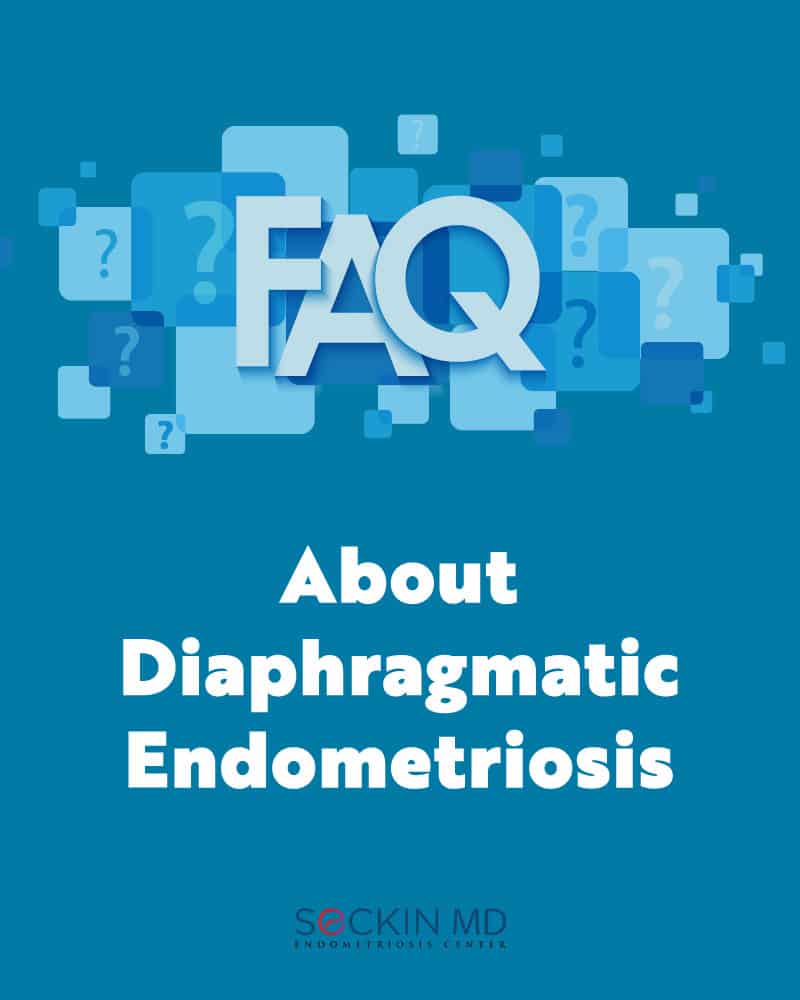Diaphragmatic Endometriosis FAQ

Diaphragmatic endometriosis is a rare form of endometriosis. Here are some FAQs about the disease.
What is the diaphragm?
The diaphragm is a large, dome-shaped involuntary muscle that is located below the lungs. The diaphragm separates the abdominal cavity from the thoracic cavity. Contraction and expansion of the diaphragm help with breathing.
What is diaphragmatic endometriosis?
Diaphragmatic endo is a rare form of endometriosis in which tissue resembling the lining of the uterus starts growing in and around the diaphragm. This tissue reacts to the hormones of the menstrual cycle in the same way as normal endometrial tissue. However, unlike the normal endometrium, this tissue has no way to exit the body resulting in inflammation and pain.
How does it differ from thoracic endometriosis?
Thoracic endometriosis is a form of extra-pelvic endometriosis like diaphragmatic endo. However, thoracic endometriosis is a more widespread form of extra-pelvic endometriosis. For example, endometrial tissue can occur in the diaphragm, lungs, pleural layers, and trachea. In contrast, diaphragmatic endometriosis only occurs in the diaphragm.
How common is it?
Diaphragmatic endometriosis is rare, affecting approximately 1 to 1.5% of endometriosis patients.
What causes it?
Like other types of endometriosis, the exact cause of diaphragmatic endometriosis is not clear. Retrograde menstruation may be one possible mechanism in which endometrial tissue implants in extra-pelvic regions. Other causes include immune system disorders and genetic factors.
What are the symptoms?
Diaphragmatic endometriosis may not have symptoms in up to 70% of cases. When symptoms are present, they include pain in the upper right abdominal region and lower ribs, painful breathing, and nausea and vomiting during menstruation.
Endometrial lesions stimulating the phrenic nerve, which controls the diaphragm may be the cause of chest and abdominal pains.
How do doctors diagnose diaphragmatic endometriosis?
A combination of physical examination and imaging techniques such as magnetic resonance imaging (MRI), computerized tomography (CT), and chest X-ray can help diagnose diaphragmatic endometriosis.
Doctors should also take a thorough medical history of the patient particularly asking about complaints of chest pain during menstruation.
A confirmed diagnosis is only possible via laparoscopic inspection of the diaphragm by an experienced endometriosis laparoscopic surgeon followed by a biopsy.
Why is diaphragmatic endometriosis underdiagnosed?
The low prevalence and majority of the cases being asymptomatic contribute to the under-diagnosis of diaphragmatic endometriosis.
The lack of suspicion by clinicians is also a reason why diaphragmatic endometriosis often goes undiagnosed.
During the laparoscopic examination, surgeons should assess both sides of the diaphragm even though the patient reports symptoms only on one side.
What are sentinel lesions?
Sentinel lesions are those that indicate the presence of diaphragmatic endometriosis. They are generally superficial and on the right side of the anterior diaphragm, indicating the presence of lesions on the posterior side. The right lobe of the liver hides the area between the diaphragm and the posterior edge of the liver, and this is generally the area where endometrial implants occur. An experienced surgeon can search for these lesions via laparoscopy.
What are the available treatment options?
Diaphragmatic endometriosis is treated symptomatically and by surgical interventions.
Symptomatic treatment involves the use of combined oral contraceptives (COCs), progestins, or gonadotropin-releasing hormone (GnRH) agonists to treat the symptoms. COCs must be administered with caution as they can lead to estrogen dominance and cause further disease progression.
Minimally invasive surgical techniques such as laparoscopic excision surgery and video-assisted thoracoscopic surgery (VATS) can help in identifying and removing large lesions without having to perform laparotomy (open abdominal surgery) or thoracotomy (open chest surgery). Laparoscopic excision surgery is the gold standard for surgical treatment of any type of endometriosis.
Have you had any experience with diaphragmatic endometriosis? Please share your experience and comment on our post on Facebook or Instagram.
Get a Second Opinion
Our endometriosis specialists are dedicated to providing patients with expert care. Whether you have been diagnosed or are looking to find a doctor, they are ready to help.Our office is located on 872 Fifth Avenue New York, NY 10065.
You may call us at (646) 960-3080 or have your case reviewed by clicking here.